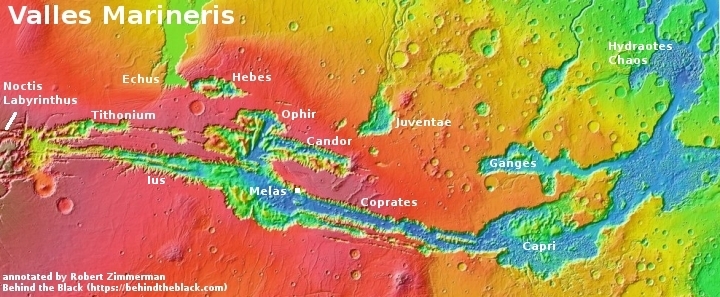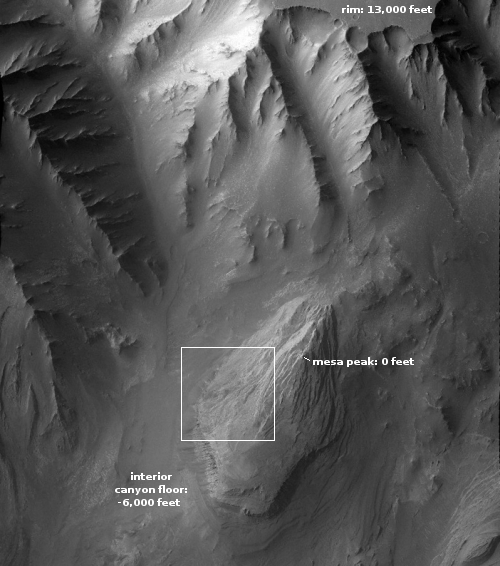From the rim to the floor of Valles Marineris

For today’s cool Martian image, we begin from afar and zoom in. The overview map above shows the solar system’s largest canyon, Valles Marineris, 1,500 miles long, and 400 miles wide at its widest. The white dot on the north rim of the section of the canyon dubbed Melas marks the location of the photo to the right, rotated, cropped and reduced to post here and taken on January 28, 2011 by the wide angle context camera on Mars Reconnaissance Orbiter (MRO).
I have added elevation numbers to this picture to give it some understandable scale. From the rim to the interior canyon floor — a distance of about ten miles — the canyon wall drops about 19,000 feet. Compare this with Bright Angel Trail in the Grand Canyon, which from the rim to the Colorado River drops about 4,400 feet in about the same distance. The wall of Valles Marineris is about four times steeper.
Even that doesn’t give you the full scale. Having hiked down to that interior canyon floor, you are still about 10,000 feet above Valles Marineris’s main canyon floor, with fifteen more miles of hiking to go to reach it.
The white rectangle marks the area covered by the MRO high resolution image below.
The close-up to the right, rotated, cropped, and reduced to post here, was taken on December 25, 2021 by MRO’s high resolution camera. It rightly labels what we see as “steep layered deposits.” From peak to floor the western wall of this mesa inside Valles Marineris drops about 6,000 feet in only about two and a half miles, making it very comparable to a typical wall of the Grand Canyon. Yet this wall is only part of one mesa half the height of this huge Martian canyon.
And like a typical Grand Canyon wall, this mesa is heavily layered, with much of the geology mostly shaped by wind erosion. And though flowing water played an important factor in shaping this terrain — like the Grand Canyon — water plays no part now. On Mars this canyon, located in the red planet’s equatorial regions, has likely been dry for more than a billion years. It does not get periodic thunderstorms. When water shaped it that water arrived in singular catastrophic floods, like released from underground ice heated by volcanic eruptions.
On Christmas Eve 1968 three Americans became the first humans to visit another world. What they did to celebrate was unexpected and profound, and will be remembered throughout all human history. Genesis: the Story of Apollo 8, Robert Zimmerman's classic history of humanity's first journey to another world, tells that story, and it is now available as both an ebook and an audiobook, both with a foreword by Valerie Anders and a new introduction by Robert Zimmerman.
The print edition can be purchased at Amazon or from any other book seller. If you want an autographed copy the price is $60 for the hardback and $45 for the paperback, plus $8 shipping for each. Go here for purchasing details. The ebook is available everywhere for $5.99 (before discount) at amazon, or direct from my ebook publisher, ebookit. If you buy it from ebookit you don't support the big tech companies and the author gets a bigger cut much sooner.
The audiobook is also available at all these vendors, and is also free with a 30-day trial membership to Audible.
"Not simply about one mission, [Genesis] is also the history of America's quest for the moon... Zimmerman has done a masterful job of tying disparate events together into a solid account of one of America's greatest human triumphs."--San Antonio Express-News

For today’s cool Martian image, we begin from afar and zoom in. The overview map above shows the solar system’s largest canyon, Valles Marineris, 1,500 miles long, and 400 miles wide at its widest. The white dot on the north rim of the section of the canyon dubbed Melas marks the location of the photo to the right, rotated, cropped and reduced to post here and taken on January 28, 2011 by the wide angle context camera on Mars Reconnaissance Orbiter (MRO).
I have added elevation numbers to this picture to give it some understandable scale. From the rim to the interior canyon floor — a distance of about ten miles — the canyon wall drops about 19,000 feet. Compare this with Bright Angel Trail in the Grand Canyon, which from the rim to the Colorado River drops about 4,400 feet in about the same distance. The wall of Valles Marineris is about four times steeper.
Even that doesn’t give you the full scale. Having hiked down to that interior canyon floor, you are still about 10,000 feet above Valles Marineris’s main canyon floor, with fifteen more miles of hiking to go to reach it.
The white rectangle marks the area covered by the MRO high resolution image below.
The close-up to the right, rotated, cropped, and reduced to post here, was taken on December 25, 2021 by MRO’s high resolution camera. It rightly labels what we see as “steep layered deposits.” From peak to floor the western wall of this mesa inside Valles Marineris drops about 6,000 feet in only about two and a half miles, making it very comparable to a typical wall of the Grand Canyon. Yet this wall is only part of one mesa half the height of this huge Martian canyon.
And like a typical Grand Canyon wall, this mesa is heavily layered, with much of the geology mostly shaped by wind erosion. And though flowing water played an important factor in shaping this terrain — like the Grand Canyon — water plays no part now. On Mars this canyon, located in the red planet’s equatorial regions, has likely been dry for more than a billion years. It does not get periodic thunderstorms. When water shaped it that water arrived in singular catastrophic floods, like released from underground ice heated by volcanic eruptions.
On Christmas Eve 1968 three Americans became the first humans to visit another world. What they did to celebrate was unexpected and profound, and will be remembered throughout all human history. Genesis: the Story of Apollo 8, Robert Zimmerman's classic history of humanity's first journey to another world, tells that story, and it is now available as both an ebook and an audiobook, both with a foreword by Valerie Anders and a new introduction by Robert Zimmerman.
The print edition can be purchased at Amazon or from any other book seller. If you want an autographed copy the price is $60 for the hardback and $45 for the paperback, plus $8 shipping for each. Go here for purchasing details. The ebook is available everywhere for $5.99 (before discount) at amazon, or direct from my ebook publisher, ebookit. If you buy it from ebookit you don't support the big tech companies and the author gets a bigger cut much sooner.
The audiobook is also available at all these vendors, and is also free with a 30-day trial membership to Audible.
"Not simply about one mission, [Genesis] is also the history of America's quest for the moon... Zimmerman has done a masterful job of tying disparate events together into a solid account of one of America's greatest human triumphs."--San Antonio Express-News



